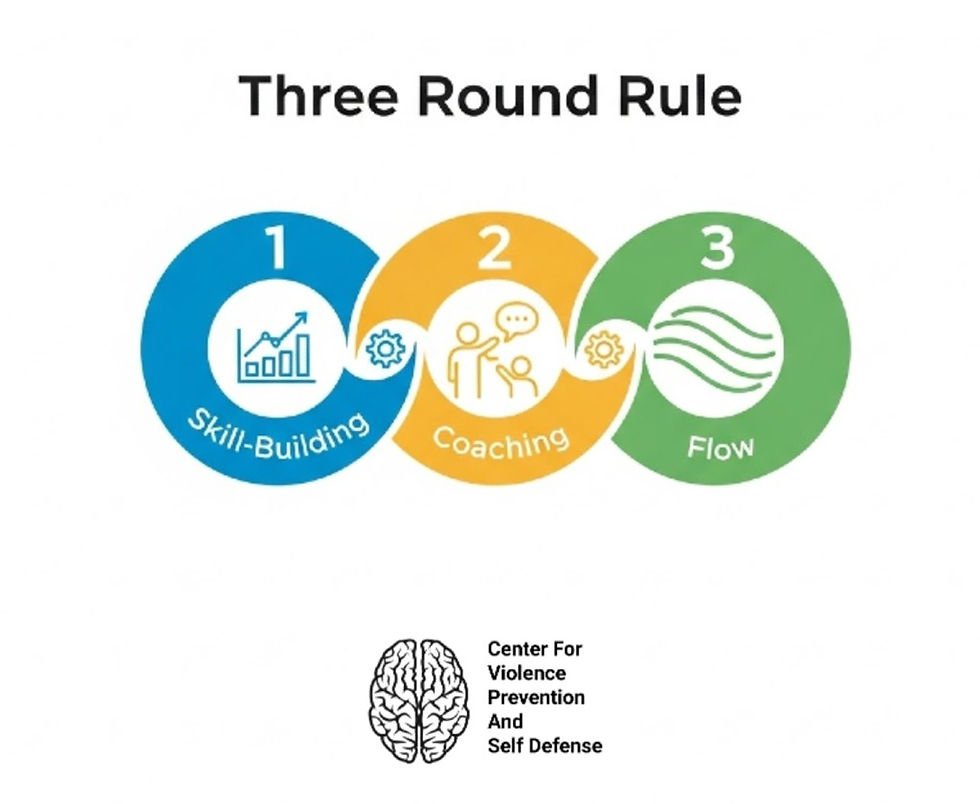The Three Round Rule: Smarter Self Defense Training, Stay Safe, Thrive Longer
- william demuth

- Aug 19
- 4 min read
Updated: Nov 12
The Key to Lifelong Smarter Self-Defense Training
Self-defense training is a grind some of the most empowering moments of your life come on the mat, but so do some of the worst injuries. One wrong move, one overly aggressive partner, or one ego-fueled spar can put you out for weeks.
For those of us with jobs, families, or responsibilities, showing up to life injured isn’t an option. That’s why we developed The Three Round Rule a system to keep you training consistently, building real-world skills, and protecting your body from burnout.

How Physical Training Takes a Toll
In your 20s, you could muscle through sloppy technique or reckless sparring and feel fine the next day. But as you age, recovery slows. Shoulders suffer from repetitive choke defenses or overzealous clinch work.
Knees take a beating from takedown drills or awkward sprawls.
Back and neck pay the price for bad posture or refusing to tap early.
The “go hard or go home” mindset doesn’t cut it anymore. To stay in the game, you need to train with purpose. The Three Round Rule is your blueprint for sustainable, effective self-defense training.
The Three Round Rule (Explained)
Here’s how it works for a typical self-defense session: Three Rounds Normal
These are your standard sparring rounds. Train at a realistic pace think controlled, practical self-defense scenarios, not an all-out brawl. Practice defending strikes, escaping holds, or countering attacks while staying mindful of your energy and technique.
One Round for Skill-Building
This is your technique lab. Pick one move to sharpen, like a wrist escape, a takedown defense, or a strike counter. Tell your partner: “Let’s slow it down I’m working on my elbow escape.” You’re drilling within a live spar, refining precision without the intensity.
One Round for Coaching
Pair up with a beginner or less-experienced partner. Guide them through a technique, like a basic choke escape or clinch defense. You’re not overpowering them you’re teaching. This reinforces your skills while giving your body a lighter round.
One Round for Flow
Flow sparring is a secret weapon for self-defense. Move smoothly between positions standing to ground, clinch to escape and practice catch-and-release submissions (e.g., set up a choke and let it go). Focus on movement and timing, not grinding for control. It’s low-impact but builds real-world instincts.
Why It Works
Built-In Recovery: Varying intensity across rounds keeps you active without overtaxing your body. You train hard but smart.
Skill Over Ego: The skill-building round hones technique, reducing injury risk while making you sharper for real-world scenarios.
Coaching Deepens Mastery: Teaching a beginner solidifies your fundamentals. It’s learning amplified, plus you’re helping the team grow.
Flow Enhances Longevity: Flow rounds sharpen timing, cardio, and adaptability while sparing your joints. It’s training that mimics real self-defense without the wear and tear.
Why It’s Safer
Sitting out might seem like the safe choice, but it’s a trap. The longer you sit, the stiffer you get, and the less ready you are for action. The Three Round Rule keeps you moving and engaged:
Safer for Joints: Less grinding means fewer injuries.
Safer for Energy: You won’t burn out early and risk sloppy, dangerous moves.
Safer for Ego: Structured rounds set clear expectations, so you’re not tempted to “prove yourself” every time.
What It Looks Like in Practice
Picture a six-round self-defense session:
Rounds 1–3 (Normal): Spar at a controlled pace with solid partners. Practice defending punches, escaping grabs, or countering a takedown.
Round 4 (Skill-Building): “Hey, let’s go slow I’m working on my wrist escape from a grab.” You rep the move in a live but controlled spar.
Round 5 (Coaching): You guide a newer student through a basic choke defense, letting them work while you offer pointers.
Round 6 (Flow): You move fluidly transition from standing to ground, set up a submission, and release it. No grinding, just smooth, instinctive movement.
Six rounds, no sitting out, no beating yourself up. You leave the gym sharper, stronger, and ready for the real world.
The Mental Edge
The toughest part of training isn’t always physical it’s mental. You don’t want to feel like you’re falling behind or can’t keep up. The Three Round Rule keeps you active, contributing, and training smarter than the reckless crowd. You’re not just surviving sessions you’re building a foundation for lifelong skill.
Train Smart, Thrive for Life
The Three Round Rule is more than a training system it’s a mindset shift. It’s about prioritizing longevity, mastering practical self-defense skills, and staying ready for whatever life throws at you. By training smarter, you’re not just protecting your body building confidence, resilience, and a legacy on the mat. Start using the Three Round Rule today, and take control of your training journey. Keep showing up, keep growing, and keep defending today, tomorrow, and for years to come.
Online Violence Prevention and Defensive Tactics Training Brought To You By Generous Supporters
The Center for Violence Prevention and Self-Defense (CVPSD) is a nonprofit organization dedicated to reducing violence by educating at-risk individuals and communities.
Through a combination of online and in-person training, workshops, and seminars, CVPSD provides practical self-defense skills, violence prevention strategies, risk assessment tools, and guidance on setting personal and relationship boundaries.
